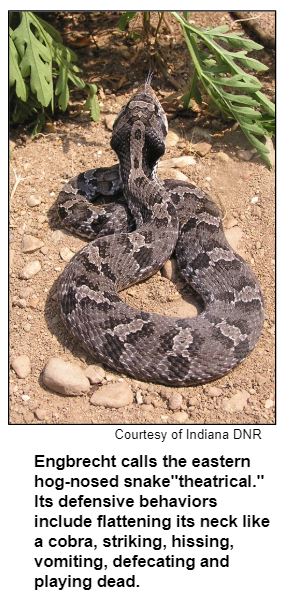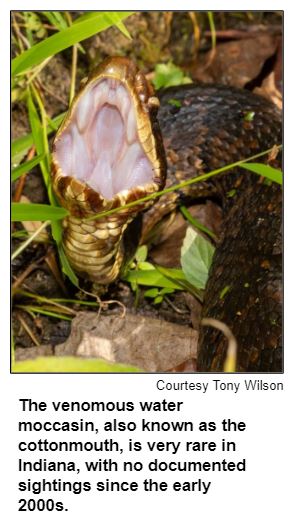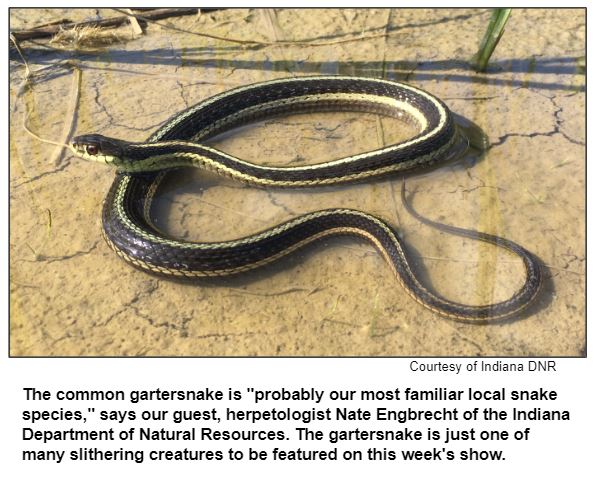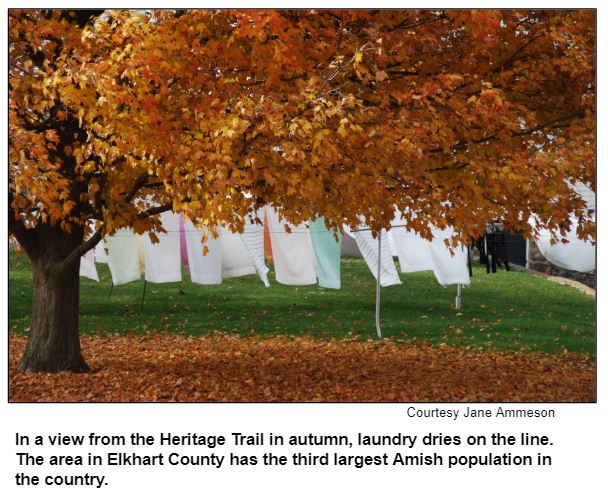
Saturdays, noon to 1 p.m. ET on WICR 88.7 FM.
Or stream audio live from anywhere on WICR Online!
You can listen to recent shows by clicking the podcast links below, or check out our extensive archive of past shows available as podcasts.
August 1, 2020
Snakes slithering across Indiana

Hoosier History Live will spotlight those four - including the most rare, the dreaded water moccasin (also known as the cottonmouth) - along with a range of others in the spectrum of snake species. We also will discuss a lizard that's often mistaken for a snake because it is legless.

Some tidbits about a few of the snakes that can be found on Hoosier soil (or in the water):
- Common gartersnake: Harmless to humans, it is "probably our most familiar local snake species," Nate says. Some Hoosiers call it a "gardener snake" or "garden snake."
- Water moccasin/cottonmouth: "A lot of people think they see water moccasins in Indiana, but the species is very rare," Nate says. "It has been documented at only one or two Indiana sites, and has not been verified in the state in over a decade. We have a number of non-venomous water snakes that are probably what most people are seeing." Documented sites have been in Dubois County and in Harrison County, along the Ohio River. But Nate emphasizes that only the Dubois County site is thought to still have the possibility of resident water moccasins – and the species has not even been seen there since the early 2000s. "So their current status in the state is undetermined."
- Copperheads: These venomous snakes are somewhat widespread in southern Indiana.
- Gray rat snake: Although it can be found statewide, the gray rat snake (sometimes called a "black rat snake" or, simply, a "black snake") also is most prevalent in southern Indiana.
- Eastern hog-nosed snake: It's not especially common, but can be found across Indiana, Nate says. "This is the most 'theatrical' of our snakes," he adds, noting its "elaborate defensive display that involves flattening its neck like a cobra, striking, hissing, vomiting, defecating and, in a grand finale, [it] will turn over on its back and play dead - mouth agape with tongue hanging out." Eastern hog-nosed snakes eat toads and frogs.

Glass lizards - which are found in grasslands, sandy woods and the Dunes in northwest Indiana - are so named because their tails tend to break easily when they are handled. The tails regenerate, but the replacement often is not as long as the original, Nate says.
He adds that, although glass lizards are "snake-like in appearance," they have eyelids and ear openings, features lacking in snakes found in Indiana.
Across the state, lakes, marshes, ponds, ditches and other aquatic habitats are home to the common watersnake that often is mistaken for a water moccasin. Although the common watersnake is not venomous, Nates says they tend to be "feisty when handled."
Another species that can be found statewide is the eastern milksnake. A medium-sized snake that sometimes has a brilliant red body, the eastern milksnake occasionally is discovered around farms and barns.
It is not venomous, nor is Dekay's brownsnake, which Nate describes as a small, unassuming snake that typically is gray or brown. He notes that the Dekay's brownsnake benefits gardeners by eating slugs.
Nate joined botanist Michael Homoya as a guest last November for a Hoosier History Live show about rare species of plants and animals in Indiana.
Roadtrip: Heritage Trail and Amish country in Elkhart County
Guest Roadtripper, author, and food and travel writer Jane Ammeson tells us to avoid the crowds and wander the back roads of the nationally recognized Heritage Trail in northern Indiana. The driving tour courses through the heart of Indiana's Amish country; you'll travel through quaint towns and villages and see horse-and-buggy carriages rolling past verdant farms.
Jane tells us that the area around Elkhart County has the third largest Amish population in the country after Lancaster, Penn. and Holmes County, Oh. Heritage Trail users will see Hoosier towns like Middlebury, Nappanee, Wakarusa and Shipshewana that are rich in Amish history and culture. To learn more about the Amish in Indiana, check out a Hoosier History Live show we did in 2013.
The Heritage Trail is well marked for drivers, and access to the audio guide is free! Moreover, this is a great activity during the Covid-19 pandemic; you can stay in your car and get out to explore the local history spots on your own, away from the crowds!
Other must-see spots for visitors to the area:
- Bonneyville Mill, Indiana's oldest continuously operating grist mill. And for those willing to venture a bit off the trail, Bonneyville Cemetery, where lies William Tufts, a Revolutionary War hero who fought alongside George Washington and was a participant in the Boston Tea Party.
- Sixteen different quilt gardens, each planted with thousands of blooms to represent a quilt design.
- The charming small city of Goshen, where you'll enjoy visiting such delightful shops as the Old Bag Factory.
- And Elkhart, home to the Beaux Arts mansion Ruthmere, now a house museum, and Wellfield Gardens, a 250-acre botanical garden.
History Mystery
Just as with snakes, misconceptions abound about spiders. And like snakes, only a few species of spiders in Indiana are venomous, according to Marc Milne, an assistant professor of biology at the University of Indianapolis and one of the nation's top spider specialists. Marc, who has made breakthroughs in spider research, joined Nelson as a studio guest last Halloween weekend for a show about spiders across Indiana.
During the show, Marc noted that many people incorrectly assume that spiders are insects. Actually, they have a different classification in the animal kingdom.
Question: What is the biological classification for spiders?
Hint: The difference between insects and spiders has to do with the number of their legs, among other characteristics.
The call-in number is (317) 788-3314. Please do not call in to the show until you hear Nelson pose the question on the air, and please do not try to win if you have won any other prize on WICR during the last two months. You must be willing to give your first name to our engineer, you must answer the question correctly on the air and you must be willing to give your mailing address to our engineer so we can mail the prize pack to you.
The prizes this week are two tickets to the Indiana State Museum, courtesy of the Indiana State Museum, and two tickets to Indy's Teeny Statue of Liberty Museum, courtesy of Tim and Julie's Another Fine Mess.
Nelson Price, host and historian
Molly Head, producer/general manager, (317) 927-9101
Mick Armbruster, associate producer
Cheryl Lamb, administrative manager
Richard Sullivan, senior tech consultant
Pam Fraizer, graphic designer
Garry Chilluffo, consultant
Please tell our sponsors that you appreciate their support!

 For organizational sponsorship, which includes logos, links, and voiced credits in the show and in podcasts, email molly@hoosierhistorylive.org, or call (317) 927-9101 for information. Our podcast listens are increasing at a rate of 17% a month and we are being distributed on Indiana Memory and the National Digital Public Library. As we have always believed, the internet distribution of Hoosier History Live is taking us to the top! Thanks also to Visit Indy, Fraizer Designs, WICR-FM, Henri Pensis, Aaron Duvall, Kielynn Tally, Justin Clark, and many other individuals and organizations.
For organizational sponsorship, which includes logos, links, and voiced credits in the show and in podcasts, email molly@hoosierhistorylive.org, or call (317) 927-9101 for information. Our podcast listens are increasing at a rate of 17% a month and we are being distributed on Indiana Memory and the National Digital Public Library. As we have always believed, the internet distribution of Hoosier History Live is taking us to the top! Thanks also to Visit Indy, Fraizer Designs, WICR-FM, Henri Pensis, Aaron Duvall, Kielynn Tally, Justin Clark, and many other individuals and organizations.
Thank you!
We'd like to thank the following recent, new and renewal contributors whose donations help make this show possible!
- Dr. Robert and Jill Clements
- Tom Spalding
- Ryan Zumbahlen
- David Yount
- Linda Gugin and Jim St. Clair
- Doug Winnings
- Peggy Sabens
- Carl and Kathleen Widland
- Carol Bacon
- Rachel Perry
- Tom Swenson
- Dr. James Madison
- Stacia Gorge
- Dr. Geoffrey Golembiewski
August 8, 2020 - coming up
Olympians with intriguing pre- and post-games lives

Regardless, Hoosier History Live will spotlight Olympians with connections to Indiana who competed in an array of sports for more than 100 years. Rather than focusing on superstars such as Mark Spitz, the swimmer who captured a then-record seven gold medals at the 1972 Munich Olympics, or basketball sensation Larry Bird and others on the "Dream Team" of the 1992 Barcelona Olympics, we will explore Olympians whose lives, before or after the games in which they competed, involved compelling - and sometimes little-known - personal stories.
Among the stories of Hoosier-connected Olympic athletes we'll explore:
- A gold medalist in the long jump who grew up in poverty and recently retired, at age 89, from a career as a dentist at Logansport State Hospital.
- The first African-American gold medalist in the decathlon who, after the 1956 Melbourne Olympics, became a pro football player - and, according to several accounts, was fired for marrying a white woman.
- Hoosier athletes who followed up their Olympics experiences by becoming FBI agents and, in at least one case, a Navy SEAL.
Our guide as we make our way through these inspiring stories of athletic excellence will be Indianapolis Star sportswriter David Woods, who has covered every Summer Olympics since the 1996 Atlanta Olympics. (Even before that, he began interviewing Olympians in 1972 and, as a freelancer, wrote about the 1984 Los Angeles Olympics). David is the author of a new book, Indiana University Olympians (IU Press), which features profiles of 49 diverse athletes.

Following his triumph at the Olympics in the long jump and two NCAA championships (he never lost a collegiate competition while at IU, David notes), Greg Bell attended the IU School of Dentistry. He paid his way through dental school by working on a farm near Indianapolis.
Other athletes at the 1956 Olympics included Milt Campbell (1933-2012), who was born in New Jersey but attended IU in the 1950s. He became the first African-American gold medalist in the decathlon but suffered from "a lack of recognition during much of his lifetime," David writes. Excelling in swimming, wrestling, judo and other sports, Milt Campbell played football at IU for two years. In 1957, he was chosen by the Cleveland Browns in the NFL draft, but lasted only one season.
"He was cut apparently because of his off-season marriage to a white woman," according to Indiana University Olympians. David's book points out that Campbell is the only athlete to have been inducted into both the National Track and Field Hall Fame and the International Swimming Hall of Fame.© 2020 Hoosier History Live. All rights reserved.
|







